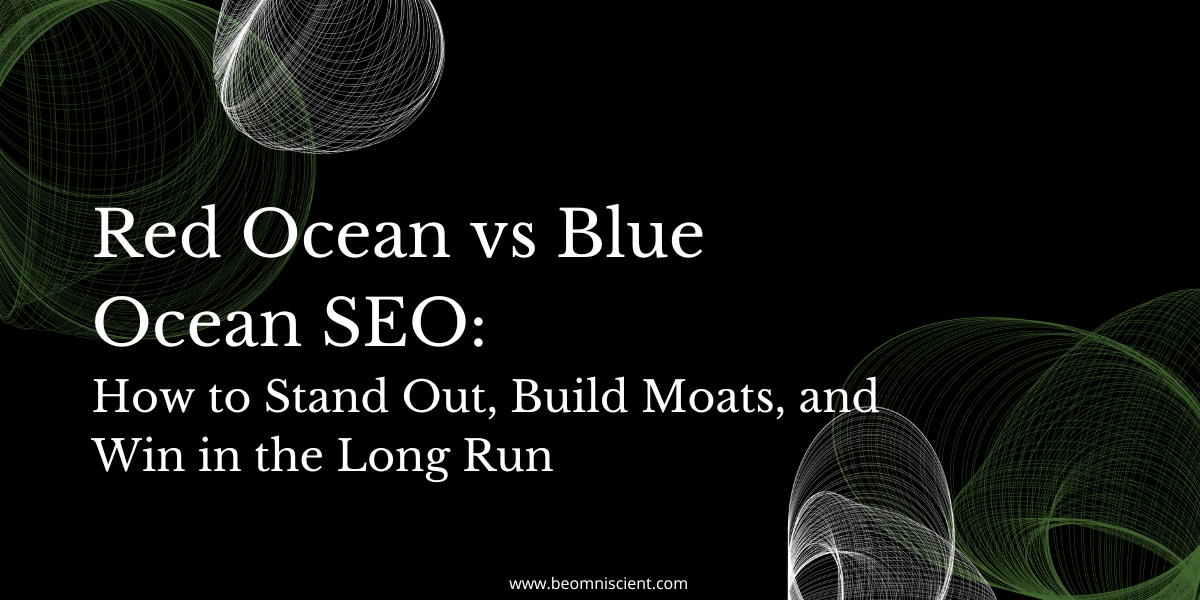
SEO strategy never exists in isolation.
There are dynamic elements that impact how you approach content, including:
- Your target audience
- Your product and GTM strategy
- Your unique strengths and budget
…and of course, the presence of competition.
The presence and strength of competition helps determine the cost you should pay for content, the payback period of your efforts, the channels by which you should distribute content, and even how you should craft and create your content.
A simple way to look at this is the Red Ocean vs Blue Ocean framework.
Red Oceans vs Blue Oceans
This concept comes from the book “Blue Ocean Strategy.”
Red Oceans are all the industries in existence today – the established market space. In red oceans, “industry boundaries are defined and accepted, and the competitive rules of the game are known.”
A Blue Ocean, in contrast, is a space where there are no yet established boundaries or rules. In blue oceans, “demand is created rather than fought over. There is ample opportunity for growth that is both profitable and rapid.”
Most of the time, this is denoted at the industry level.
An example of a blue ocean strategy is Stich Fix. Operating in the generally crowded retail fashion space, they differentiated by leveraging both artificial intelligence as well as human guides to open new market space in retail. There have since been new competitors in this space, but they opened up the market and started the movement.
Most of us operate in red oceans. If you’re starting a new CRM, for example, you’re in a red ocean.
Beyond the industry-level, we also have to delineate between red ocean and blue ocean search spaces.
Most Oceans in SEO are Blood Red (Why and What to Do)
Most of us are red ocean companies operating in red ocean search spaces.
We all have access to the same tools nowadays.
If you can look up a keyword in Ahrefs, so can your competitor.
If you can write the piece using Jasper, so can your competitor. If you can optimize it using Surfer, so can your competitor.
That’s why I always say you shouldn’t copy HubSpot’s content strategy. They started decades ago when the space was very blue ocean, and now they’ve built up a moat with their website authority, budget for content, and existing audience and brand.
There’s nothing wrong about building a strategy in a red ocean, so long as you have a unique advantage that gives you a reasonable chance of winning (or at least generating marginal ROI).
Blue ocean strategies, lacking competition and existing demand, are higher risk (but therefore higher reward). And even if you pull ahead in a blue ocean, competitors quickly swim in, making the ocean red. Thus, the goal here is to move fast and build a moat.
The rest of this piece will cover specific strategies to help you win the search game whether you’re in a red ocean or a blue ocean.
Red Ocean SEO Strategies
Companies playing to win in in red oceans have two paths they can take:
- Fisherian runaway (competing to the bottom)
- An unfair advantage (competing to the top)
Fisherian Runaway SEO Strategies
I like to read from dissociated topics and connect them to business (see: barbell strategy for content).
One area I’ve gone down is evolutionary biology. There’s a theory of evolution and sexual selection called “Fisherian Runaway” that seeks to explain exaggerated male traits like the Peacock’s tail:
“Fisher developed the theory further by assuming genetic correlation between the preference and the ornament, that initially the ornament signalled greater potential fitness (the likelihood of leaving more descendants), so preference for the ornament had a selective advantage. Subsequently, if strong enough, female preference for exaggerated ornamentation in mate selection could be enough to undermine natural selection even when the ornament has become non-adaptive”
It might be a stretch, but I view certain marketing behaviors like this. For example, the Skyscraper Technique.
Google’s “fitness signal” being comprehensiveness, marketers started to optimize for that, reverse engineering articles that already ranked and added 500 words and some images, maybe another item on a listicle.
However, once you skyscrape, it’s only a matter of time before you, too, are skyscraped. Victor Pan hilariously tweeted about this in reference to the 4, 5, 6, 22 P’s of Marketing:
It reminded me of the scene in There’s Something About Mary where the hitch hiker pitches 7 minute abs (“what if someone comes along with 6 minute abs…)
The end result of this trends towards unusable content for readers. What the hell are you going to do with 100+ CRO tactics?
And do we really need 60+ SEO experts to tell us their tools?
In Fisherian SEO, there’s strong competition and tactics snowball to the point of absurdity. To stand out, you need MORE links, MORE content, MORE everything until the cost of doing business supersedes any potential ROI.
If you have the capital and patience to play this game, you can still win. But it’s very difficult to build a moat this way, and one of the most important functions of content & SEO is to build a moat that is hard to compete with.
But if you don’t have those assets, you’ll want to play a different game, one that hinges on your unique advantages.
How?
- Index on a unique advantage
- Index on untapped keywords
- Distribute outside of Google
Index on a Unique Advantage
We start every client engagement with a SWOT analysis – an old, stodgy, and boring business school tool.
Why? Because it helps us identify the specific weaknesses and threats we need to get around, but more importantly the strengths we can lean on and the opportunities to build huge hurdles for the competition in the future.
Your unique advantage is going to be a function of the existing space and competition as well as the things that only you can do well.
One of my favorite examples is MasterClass. While they are operating in a truly red ocean search space, they had several advantages that allowed them to pull ahead:
- A product-led content motion that allowed for direct response content conversions
- Subject matter experts to lead the creation of their content (they just used content from their courses to angle for existing keywords)
- A huge marketing budget to scale up content and links rapidly
- A complementary paid acquisition strategy that leveraged high intent content to create surround sound effects with remarketing ads
If you’re starting a new CRM company, you have to think “what can I do that HubSpot can’t do?” The answer won’t be easy. It might even mean you have to operate in channels outside of search, at least until you gain a footing to be able to compete with them.
One of the strongest unique advantages you can build is simply targeting different keywords than everyone else. Zig when they zag.
Index on Untapped & Different Keywords
We all have access to Ahrefs, and most of us simply pick the highest traffic keywords that the tool shows us. This is usually a bad idea.
Instead, think about using one of these three strategies:
- Surround Sound SEO
- Wal Mart Strategy
- Pain Point SEO
1. Surround Sound SEO
Surround Sound SEO is a uniquely advantageous strategy for startups and emerging players because it does two things at once: bolsters your brand awareness and drives direct response conversions.
It also leverages other websites instead of your own.
The goal of the surround sound strategy is to monopolize all of the SERP results for high intent keywords instead of just getting your page to rank.
Take, for example, the keyword “copywriting software.” A company selling software would certainly benefit from ranking for this keyword.
But this keyword represents a “product discovery” intent – people are searching both to discover products from which to compare as well as to eventually choose a product to use or purchase.
You can see some evidence for this by the fact that the number of clicks is larger than the estimated search volume. People click multiple pages in the SERP:
The keyword also has a decent CPC, meaning that it’s likely lucrative to bid on this keyword (meaning people are coming in with strong purchase intent).
So instead of ranking your page for this keyword, the goal should actually be to get listed on every single page that ranks for this keyword. And it’s possible, because most of these SERPs are filled with listicles:
Appearing on all the pages that rank gives you a brand awareness advantage.
It injects you into the conversation where you previously may not have appeared. Thus, you become an important player to consider because of the social proof and authority imbued by being mentioned frequently.
The quickest way to spot pages ranking for your keywords that mention your competitors but not you is to use Surround Sound from Semrush.
You also benefit from cumulative click through rates.
For each SERP position, there’s an average click through rate and if you appear on multiple listings, you capture more clicks. Appear on several of these, and the direct response revenue you can drive grows in proportion to the number of times you appear.
If you’re interested in exploring this strategy, I did a presentation on it and how we used it at HubSpot here:
2. Walmart Strategy
The Walmart Strategy still indexes on classic keyword research but it flips the script.
Instead of going after very few high traffic keywords and spending all of your time and resources doing the “skyscraper strategy,” you go after a huge volume of low traffic and low competition keywords, eventually building up a sizable basis of traffic while building up your website authority.
The name comes from Walmart’s early growth strategy, which was in opposition to the conventional wisdom of trying to identify large cities and markets and competing away profits in those areas. Instead, Walmart looked for small towns and many of them:
“In those days, Kmart wasn’t going to towns below 50,000 and even Gibson’s wouldn’t go to towns much smaller than 10,000 or 12,000. We knew our formula was working even in towns smaller than 5,000 people, and there were plenty of those towns out there for us to expand into.”
— Sam Walton, Made in America
The benefits of going for “small town” keywords is multifold:
- They’re less competitive, making it a cheaper investment to rank for them
- They’re typically higher intent, making them more lucrative, especially at scale
- Ranking for them builds your website authority and topic authority over time, eventually making it easier to land and expand to “larger city” keywords
If you’re operating in a space dominated by large players like HubSpot, I’d highly recommend going for a bottoms up keyword approach like this.
The big challenge here is in finding untapped keywords, and one of the best ways to do that is to start with customer research instead of keyword tools.
3. Pain Point SEO
Pain point SEO is the real secret to all of this. Instead of starting with keyword research, start with customer research and build from there.
As Eli Schwartz writes in Product-Led SEO:
“In this model, successful SEO begins with customer interviews and whiteboards, not on a spreadsheet with search volumes and click curves.
If your research does not find search volume for a particular category, this should not deter you but should rather excite your senses. This means there is an opportunity to create new demand for something in search, provided, of course, there’s product-market fit and an opportunity for you to be able to dominate the category.”
Eli Schwartz
Rest assured that if you hear a pain point coming up many times in customer interviews, there’s likely demand for the topic whether or not Ahrefs shows it.
Aside from the fact that low volume keywords (especially in B2B) are notoriously inaccurate in popular SEO tools, these pain points are often icebergs below the surface, and when you write about them, you put a name to them and lead the conversation.
Pain point SEO starts with the “itch” and only later seeks a keyword to append to the piece.
When I worked at CXL, all we did was pain point SEO – despite not knowing there was a name for this strategy.
To get topic ideas that no one was competing for, we stayed at the front lines of our industry. We didn’t just do this through surveys, we did it by embedding ourselves in the market:
- I went to 6+ conferences per year and we hosted 2 per year. Every conversation at these represented a chance to learn more about audience pain points.
- We included a blog reader survey in our email subscription drip campaign
- We scoured the comment section of our blog for new ideas
- We scoured communities and forums for interesting topics as well as writers
- We pulled ideas from our own agency and the pain points of our clients
Some of the topics we chose never had keyword volume that showed up in tools. Some of them did. And sometimes, we created the demand for a topic or keyword simply by writing about it and giving it voice.
This is the strategy to take if you want to both capture untapped search demand as well as create thought leadership as an emerging property of your content marketing program.
Distribute Content Outside of Google
First off, let me say this: I love SEO.
I think the content marketers who are “too good” for keywords and search are missing out on massive, compounding traffic and business value.
Most content strategies converge on organic and SEO eventually; it’s where you get compounding efforts.
On the other hand, if you don’t already have an advantage that can get you ranking, it helps to find a pond to fish in that is complementary to SEO but gets you more immediate results.
I look at content marketing like this:
- There are business goals that predicate content marketing goals. These inform content marketing KPIs.
- Your content strategy is a holistic plan with the aim of achieving those content marketing KPIs.
- Content strategy includes various facets, including the topics and angles as well as how the content is created. But it also includes distribution. Content strategy that doesn’t include a distribution plan is relying on luck, which is never a good strategy.
But distribution, to me, is broken up into short term and long term tactics.
Long term distribution channels include SEO and email marketing. They are flywheels of sorts, the type that spins faster the more effort you put into them. Each additional action raises the baseline, so you don’t have short term spikes, but sustained incremental rewards.
Short term distribution channels are sort of like the gasoline for a fire.
They help spark the flames, but you still need a solid base of wood or charcoal to keep the fire going. These channels include things like community marketing, Facebook ads, email outreach, social media marketing, or any other method of getting initial traction for your content.
The best way to do this is to build up your SEO assets while also getting results outside of SEO – strategies like PR, surround sound, podcasting / guest appearances do this.
They give you brand authority, often bring you direct conversions, and slowly build up backlinks so eventually you can rank for low competition keywords.
You then write those low competition keywords, building up topical and website authority.
Slowly and over time, you get to a place where you can compete among the giants, but the whole time you’ve been ROI positive with content marketing.
Have your cake and eat it too.
When I worked at CXL, we had a few nice distribution channels outside of SEO:
- We were heavily embedded in Slack communities for growth marketers as well as communities like Inbound.org and GrowthHackers.com. We worked with partners to help us upvote and boost our posts on these sites, which would usually generate a few thousand pageviews right after publishing.
- We quoted experts and emailed everyone we cited in the pieces and asked them to share it on social media.
- We worked on “buzzworthy content” pieces like original research and contrarian takes that we knew would go “viral” to get eyes on our blog
These would spike traffic, but would also serve to fuel the furnace of SEO and email (our actual goals).
What About Blue Ocean SEO?
Like I mentioned, most of us are actually operating in red oceans.
But what if you’re not? What if your industry is truly a blue ocean (or at least your search landscape).
Well there are two paths depending on the context:
- There is existing search demand in your space but extremely low competition
- There is no existing search demand in your space.
When there’s existing search demand but no competition yet
In the first case, your job is easy: start writing. This is rarified air. I’ve only worked with two companies that had this opportunity.
This most often occurs in spaces without mature marketing functions. For example, I worked with a B2B cannabis company. There was TONS of demand for cannabis related terminology, but almost no competition in organic search. So we just started writing and ranking for high intent terms, despite having a domain rating of like 15.
Again, this is rare.
The more likely case is that your space is nascent, your product is innovative, and thus, you don’t have much or any existing search demand to capture.
When there’s no existing demand
In this case, you have to create demand. There’s no existing appetite, so you have to incite hunger.
Like pain point SEO, this is mostly a function of finding problems, itches, pain points, and creating content that hits on those points obliquely and in a manner that can attach to existing communities or demand.
Let’s take two different examples here:
- You created a product with a unique spin on an existing category
- You created a product in an industry that is very early
For the first example, let’s use Webflow.
Webflow created a no code website and app builder, which was relatively new at the time. Most people used enterprise CMS solutions like Sitecore, open source CMSs like WordPress, simple website builders like Wix, or custom solutions built in house.
So the problem (how to create a website or app) existed. But the solution was novel and no one was talking about “no code,” at least not yet.
The play here is to simultaneously reach the audiences already in the market for website builders, enterprise CMS software, or previously WordPress users, while also creating an emerging new conversation for your category.
Inject yourself in the existing conversation and propose an alternative solution. There’s no harm in ranking for existing keywords like “best CMS” and simply explaining why yours is different or better.
Simultaneously, lead a movement. You can see above that they have tons of content on the “no code revolution,” which lifts them up, but also the industry as a whole.
For the second example, let’s use Persefoni.
Carbon accounting software is a new and emerging space with low search volume (but it’s rising).
The play here is to start producing content early, expecting that the wave will get bigger over time and you’ll establish precedence in the space. First mover advantage.
Another great example is what Gable is doing with data contracts and other industry terms that they are cementing within the existing spaces of data quality and data collaboration. Theoretically, they compete in large red oceans; however, within these red oceans, they are creating their own waves within smaller spheres.
While doing this, you also need to engage in demand creation strategies like public relations, community building, brand building, and other ways of creating a movement around not only your product but your industry as a whole.
Conclusion
Content strategy never exists in isolation. Like it or not, it depends a lot on the presence, strength, and dynamic nature of the existing competition.
Most of us operate in red ocean industries as well as red ocean search spaces. This isn’t a problem, as it’s often easier to capture demand than to create it.
But even in these spaces, one can differentiate their approach by indexing on unique advantages, finding untapped keywords, and distributing content outside of Google.
Even those in blue oceans need to worry about building content moats, as competition will flood in fast once ROI is apparent. All oceans eventually become red – the question, then, is what your winning approach will be?



